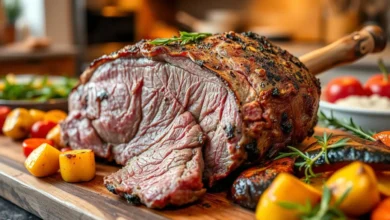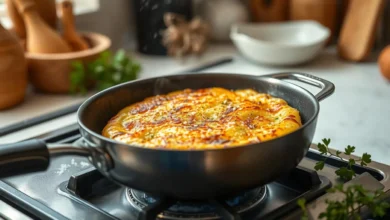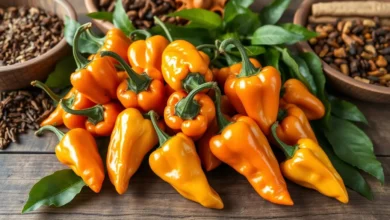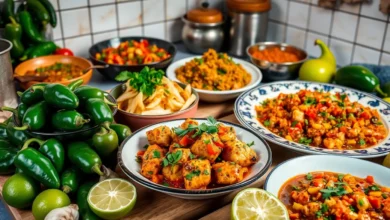How to Cook a Perfect Blade Roast: Easy Guide
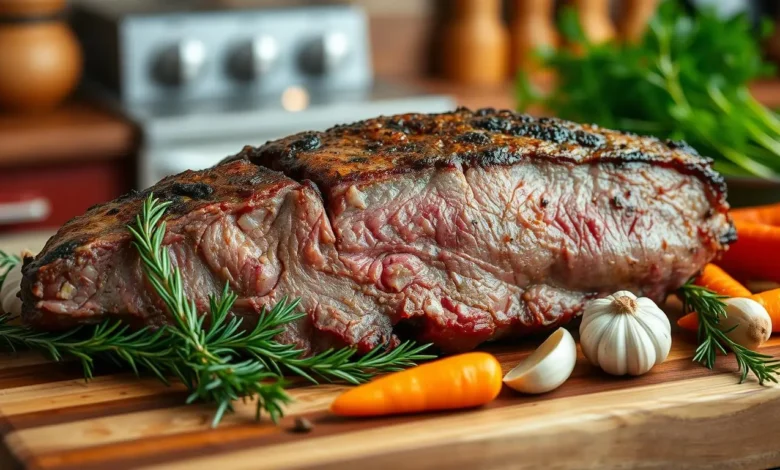
Are you a beef lover? Cooking a delicious blade roast is easier than you think. This guide will show you how to make a top-notch blade roast at home. It doesn’t matter if you’re new to cooking or have lots of experience. You’ll learn how to make a beef blade roast that will wow everyone.
Learn about the special qualities of this cut and the best ways to cook it. We’ll also share great ideas for serving it. Get ready to explore the world of beef blade roast and make a dish that will make your taste buds happy.
Understanding Blade Roast: What Makes It Special
The blade roast is a favourite in Australia for its hearty and flavourful taste. It comes from the shoulder of the cow, known as the chuck or shoulder blade. This cut is tender and full of flavour, making it a favourite among cooks and chefs.
Different Types of Blade Roast Cuts
Blade roast comes from the cow’s shoulder. There are two main cuts: the standard blade roast and the bolar blade roast. Each has its own unique qualities.
- Blade Roast: This classic cut is known for its rich, beefy flavour and moderately tender texture. It’s a popular choice for slow-cooking methods like braising or pot roasting, which help to tenderise the meat.
- Bolar Blade Roast: Considered a premium cut within the blade roast family, the bolar blade roast boasts a more tender and marbled texture. This makes it a great option for roasting or grilling, where you can showcase the meat’s natural flavours.
Meat Characteristics and Marbling
Blade roast is known for its generous marbling. This fine web of fat running through the muscle tissue adds a rich, juicy flavour. It also keeps the meat tender and succulent during cooking.
Why Choose Blade Roast for Your Meal
Blade roast is perfect for those looking for a hearty, flavourful roast. It’s versatile and can be cooked in many ways. Whether you slow-braise it or roast it at high heat, it’s sure to impress. Its tenderness and flavour make it a hit for any occasion.
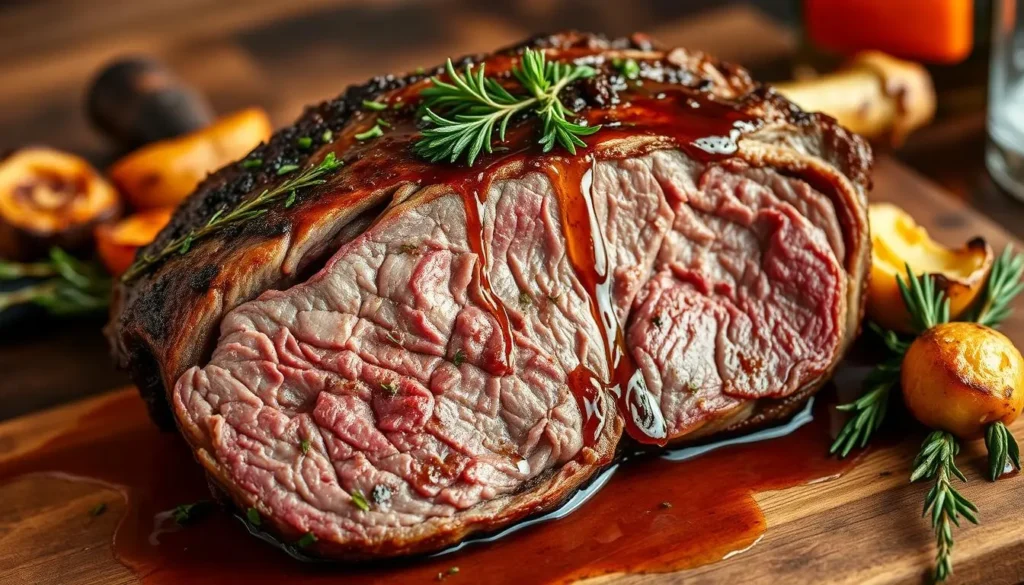
| Cut | Tenderness | Flavour | Best Cooking Method |
|---|---|---|---|
| Blade Roast | Moderately Tender | Rich, Beefy | Braising, Pot Roasting |
| Bolar Blade Roast | Tender | Robust, Flavorful | Roasting, Grilling |
Essential Tools and Equipment for Cooking Blade Roast
Cooking a perfect blade roast needs the right tools and equipment. From reliable roasting pans to precise meat thermometers, we’ll look at the must-haves. These items will help you get mouthwatering results every time you cook a blade roast.
You’ll need a sturdy roasting pan or baking dish for your blade roast. Choose one that’s heavy-duty and has high sides to catch juices. A rack or trivet to lift the meat off the pan bottom is also great. It helps with even heat and better browning.
- Quality roasting pan or baking dish
- Sturdy meat rack or trivet
- Sharp carving knife for slicing the cooked blade roast
- Meat thermometer to ensure perfect doneness
- Basting brush for applying marinades or sauces
- Tongs or carving forks for handling the hot meat
A reliable meat thermometer is key for cooking a blade roast right. It lets you check the meat’s internal temperature and avoid overcooking. Choose a digital or oven-safe thermometer for accurate readings.
Other useful items include a sharp carving knife, a basting brush, and tongs or carving forks. These make handling the hot meat easy.
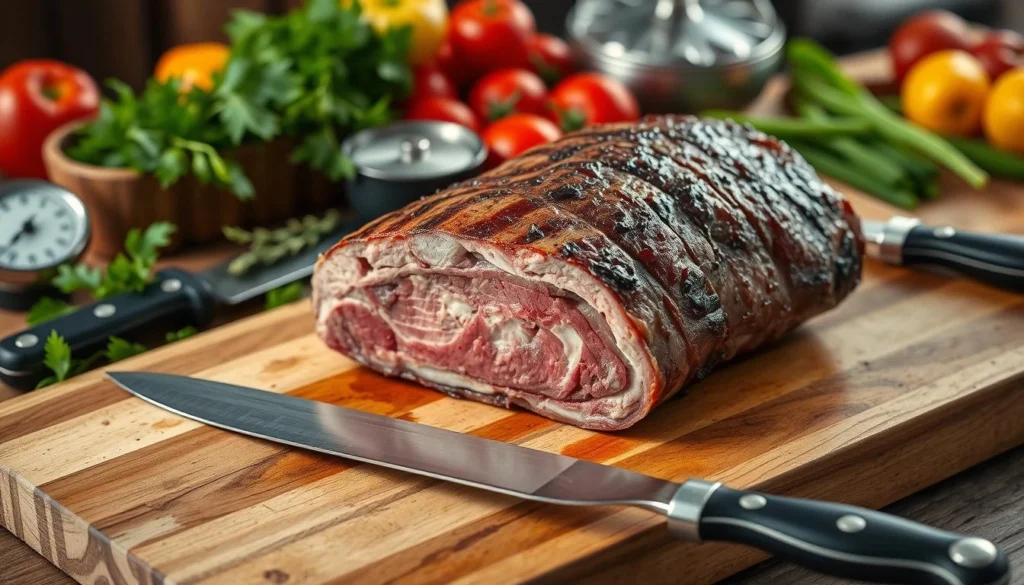
With the right tools and equipment, you’ll master cooking a blade roast. You’ll serve up a delicious, tender, and juicy meal.
Preparing Your Beef Blade Roast Before Cooking
Getting your beef blade roast ready before cooking is key for tender meat and great flavour. Start by removing any extra fat or silver skin. This helps the roast cook evenly and prevents it from burning too much on the outside.
After trimming, use kitchen string to tie the roast. This keeps it in a neat shape for even cooking.
Seasoning for Perfection
Now, season your roast to perfection. Rub it all over with salt, pepper, and your favourite herbs or spices. This lets the meat’s natural taste come through while adding extra flavour.
For the best taste, season the roast at least 30 minutes before cooking. This lets the flavours soak into the meat.
Bringing to Room Temperature
Before cooking, let your seasoned and tied roast come to room temperature. This ensures it cooks evenly, giving you a juicy inside and a crispy outside. Let it sit for 30 to 60 minutes, depending on its size.
By following these steps, you’ll make a mouthwatering how to cook beef blade roast that will wow your guests.
Best Cooking Methods for Tender Results
When cooking a blade roast, the goal is to make it tender and full of flavour. You can use a slow cooker or oven roasting. These methods can turn tough meat into something incredibly soft and tasty.
Slow Cooking for Tender Perfection
Slow cooking a blade roast in a crockpot is a great choice. It breaks down the meat’s connective tissues, making it tender. Season the roast, add veggies and broth, and let it cook for hours. This method is perfect for those who love the aroma that fills the kitchen.
Classic Oven Roasting
Oven roasting is a traditional way to cook a blade roast. Start by searing it to keep the juices in. Then, roast it at a low temperature. This method keeps the meat juicy and adds a nice crust. Make sure to check the temperature and let it rest before slicing.
Braising for Melt-in-Your-Mouth Tenderness
Braising is another excellent method for a blade roast. It involves searing the meat and then simmering it in liquid. This process makes the meat tender and full of flavour. Braising can be done on the stovetop or in the oven, and basting regularly helps keep it moist.
Choosing the right cooking method is key to a delicious blade roast. Whether you slow cook, oven roast, or braise, patience is the secret. With the right technique, your blade roast will become a family favourite.
Temperature Guide for the Perfect Blade Roast
Getting the right doneness for your blade roast is key to its flavour and tenderness. Knowing the internal temperature targets and resting times helps you cook it to perfection.
Internal Temperature Targets
The ideal internal temperature for a blade roast varies based on your doneness preference. Here’s a general guide:
- Rare: 52-55°C (125-130°F)
- Medium-rare: 57-60°C (135-140°F)
- Medium: 63-66°C (145-150°F)
- Medium-well: 68-71°C (155-160°F)
- Well-done: 74°C (165°F) and above
Resting Time Recommendations
After your blade roast hits the right temperature, let it rest before slicing. This step ensures the juices spread evenly, making the meat tender and flavourful. Rest your roast for 10-15 minutes before serving.
Using Meat Thermometers Correctly
To accurately check your blade roast’s internal temperature, use a good meat thermometer. Place the probe in the thickest part of the roast, avoiding bones or fat. Keep an eye on the temperature and take the roast off the heat a few degrees before your target. This allows the temperature to rise a bit during the rest.
By sticking to these temperature guidelines and using a meat thermometer, you’ll get a perfect blade roast every time. This will give you a tender, juicy, and tasty meal that will wow your family and friends.
Creating Delicious Marinades and Rubs
Don’t just season your beef bolar blade roast with salt and pepper. Try out tasty marinades and rubs to boost its flavour. These simple steps can turn your roast into a standout dish.
Marinades: Infusing Flavour into Your Beef Bolar Blade Roast
Marinades tenderise and add flavour to your roast. Here’s how to make great marinades:
- Use acids like wine, vinegar, or citrus to soften the meat.
- Add herbs and spices like garlic, rosemary, thyme, or black pepper for flavour.
- Try different tastes, from Asian soy sauce and ginger to Mediterranean olive oil and herbs.
- Marinate for 2-4 hours or overnight for the best flavour.
Rubs: Seasoning for Unbeatable Taste
Rubs are a simple way to season your roast. Rub spices, herbs, and seasonings on the meat for a tasty crust. Try these:
- Smoked paprika, garlic powder, and brown sugar for a smoky-sweet taste.
- Cumin, chili powder, and cayenne pepper for a spicy rub.
- Dried oregano, basil, and Parmesan cheese for an Italian flavour.
Apply the rub all over the roast. This will give you a beautiful, caramelised crust. Your guests will love it.
| Marinade Ingredients | Rub Ingredients |
|---|---|
| Red wineSoy sauceGarlicRosemaryOlive oil | Brown sugarSmoked paprikaGarlic powderSalt and pepper |
Mastering marinades and rubs opens up a world of flavour for your roast. Be creative and find your favourite mix.
Serving Suggestions and Side Dishes
Once you’ve cooked a delicious beef blade roast, it’s time to think about the perfect sides and wine. Look at classic dishes that bring out the roast’s rich flavours. Also, find wines that make your meal even better.
Classic Accompaniments
Here are some timeless sides that go great with a tasty blade roast:
- Creamy mashed potatoes: They’re soft and comforting, making a perfect match for the roast.
- Roasted vegetables: Carrots, parsnips, and Brussels sprouts add colour and flavour to your meal.
- Yorkshire pudding: This English dish has a soft inside and crispy outside, great with the roast.
- Steamed green beans: They’re fresh and crunchy, a nice contrast to the roast’s richness.
Wine Pairing Recommendations
Here are some wines that pair well with your blade roast:
- Cabernet Sauvignon: Its bold flavour goes well with the roast’s strong taste.
- Merlot: This wine is smooth and fruity, balancing the roast’s flavour.
- Shiraz: Its spicy notes complement the roast’s tender and flavourful nature.
Try these sides and wines to make your blade roast meal unforgettable. It will highlight the roast’s amazing flavour.
Storing and Reheating Leftover Blade Roast
Enjoying a delicious blade roast dinner is special. But, don’t let the leftovers go to waste. With the right storage and reheating, you can enjoy the roast’s tenderness and flavour again.
Storing Leftover Blade Roast
To keep your leftover blade roast tasty, follow these easy steps:
- Let the roast cool down completely before storing.
- Cut the meat into thin slices for even cooling and reheating.
- Put the sliced roast in an airtight container or resealable bag.
- Put the leftovers in the fridge within 2 hours of cooking for the best taste.
- Stored right, your blade roast will stay fresh in the fridge for 3-4 days.
Reheating Leftover Blade Roast
Ready to enjoy your leftover blade roast? Here’s how to reheat it perfectly:
- Heat your oven to 160°C (325°F).
- Put the sliced roast in a shallow dish and add a bit of beef broth or water.
- Cover the dish with aluminium foil to keep moisture in.
- Heat the roast in the oven for 15-20 minutes, until it’s warm through.
- You can also reheat the slices in a skillet over medium heat, adding a bit of beef broth or water.
By using these tips, you can enjoy your how to cook a blade roast days after the first time.
“Embracing leftover blade roast is a true art, allowing you to savour the best of your culinary efforts long after the first serving.”
Conclusion
You’ve learned how to cook a delicious blade roast. You now know its unique qualities and how to use the right tools. You’re ready to make meals that will wow your loved ones.
The blade roast is great for many dishes, from Sunday roasts to weeknight dinners. By using the temperature and seasoning tips from this guide, you’ll get tender, tasty roasts every time.
Now, you can try different marinades, rubs, and sides to make your blade roast special. Remember, the secret to a perfect roast is knowing the meat, preparing well, and mastering cooking. Follow these tips, and you’ll become a blade roast expert.
How to Cook a Perfect Blade Roast Every Time
FAQ
What is a blade roast?
A blade roast is a cut from the cow’s chuck or shoulder area. It’s known for being tender and full of flavour. It’s perfect for slow cooking like roasting or braising.
How do I select the best blade roast?
Choose a blade roast with lots of marbling for tenderness and juiciness. You can pick between a regular or bolar blade roast, based on your recipe.
What equipment do I need to cook a blade roast?
You’ll need a large roasting pan or Dutch oven, a meat thermometer, and a sharp knife. A meat tenderizer can also help with tough muscle fibers.
How do I prepare the blade roast before cooking?
Trim excess fat and tie the roast with string to keep its shape. Season it well with salt, pepper, and herbs. Let it come to room temperature before cooking.
What’s the best way to cook a blade roast?
Blade roast can be cooked in several ways. Oven roasting at high then low temperature is great for tenderness. Slow cooking or braising in liquid also works well.
How do I know when the blade roast is done?
Use a meat thermometer to check the internal temperature. Aim for 130-135°F for medium-rare. Let it rest for 10-15 minutes before slicing.
What are some tasty ways to season a blade roast?
Blade roast goes well with many seasonings. Try a simple rub, a mix of herbs and garlic, or a marinade with soy sauce and red wine.
What are some good side dishes to serve with blade roast?
Serve blade roast with roasted potatoes, mashed potatoes, or a green salad. Roasted vegetables, egg noodles, or a rich gravy also complement the beef well.
How can I store and reheat leftover blade roast?
Store leftover roast in an airtight container in the fridge for 3-4 days. Reheat it gently in a skillet or oven. You can also shred it for stews or sandwiches.
